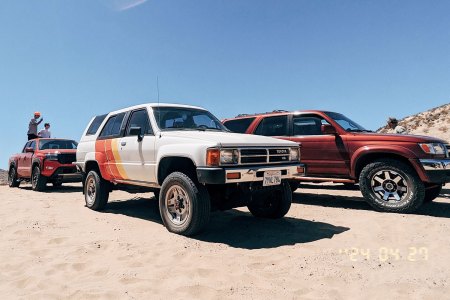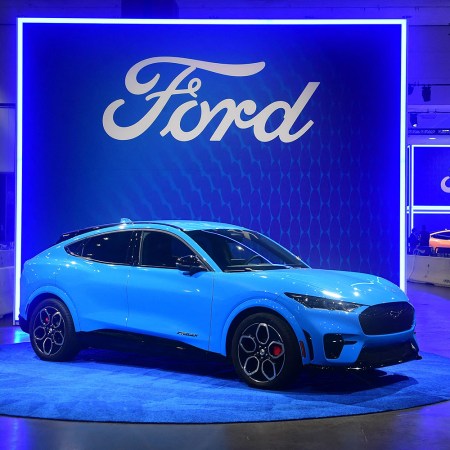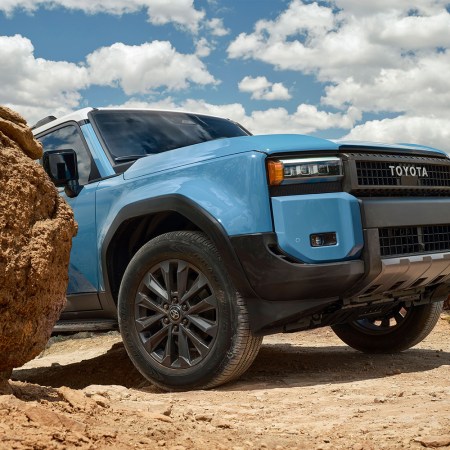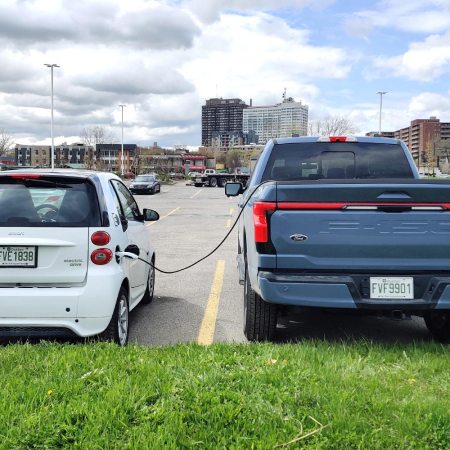Is it possible that the best pickup currently on the market is also the one that stands diametrically opposed to the bigger-is-better status quo? I’ve been of that opinion since I first slipped behind the wheel of the compact Ford Maverick and experienced firsthand what it’s like to embrace utility without suffering the gigantism of the current crop of full-size monstrosities.
Although prices have risen since the Maverick was introduced — you can no longer snag one for under $20,000, and must instead fork over $24,000 for the most affordable spec — that’s a truism of all automobiles feeling the crunch of inflation, supply-chain woes and outsized customer demand. Despite these pressures, Ford’s pint-size pickup remains the most affordable option if you’re looking for an open cargo bed, with the competitive landscape unchanged from its early days. All this, and I still haven’t mentioned the Maverick’s most potent weapon: an ultra-efficient optional hybrid drivetrain that no other truck builder can match.
With just shy of 100,000 units sold last year, and Ford well on the way to eclipsing those totals for 2024, it’s worth asking a few questions about the Maverick’s impact on the truck market. Specifically, does the smallest, cheapest and least aggro member of the pickup parade actually point the way towards the future of the segment, more so than the hyper-expensive, ultra-heavy full-size electrics like the Ford Lightning and Chevrolet Silverado EV? Or does its (relatively) singular presence on the scene indicate a doomed niche that no other automaker seems willing to touch?
Spending 500 miles with the 2024 Ford Maverick Hybrid this past week gave me plenty of time to ponder its future, and unpack how its present has forced me to question my own pickup preferences.

Once upon a time, every truck was Maverick-sized
As a teenager, my first half dozen or so daily drivers were pickups — single-cab F-150s hailing from the mid-‘80s and early-‘90s. These were simple-spec, two-wheel drive task masters, featuring Ford’s unkillable straight-six engine and a minimum of creature comforts. A bed, a bench seat and a manual gearbox were about as complicated as it got for me as I hauled myself through snow banks, down country roads and eventually down tight city streets after I moved from the countryside onto the island of Montreal.
I mention these models not to establish my own truck-loving bonafides, but because the Ford Maverick reminds me of their simple charms — and their more manageable measurements. It might shock you to find out that the compact Maverick’s 200 inches of overall length puts it smack dab in the middle of a 1985 F-150 short bed (192 inches) and long bed (208 inches), while its 72.6 inches of width give it a broader countenance than its ostensibly full-size predecessor.
Dwarfed by the current iteration of the F-Series, the Maverick is nonetheless a near-perfect throwback to the era when a human being could actually reach over the side of the bed to load and unload their gear without having to tag in a ladder or crane. Throw in sight lines that don’t obscure pedestrians crossing either in front or in back of the truck, and a four-door body style that almost doubles the passenger capacity of my old F-150s (provided we weren’t cramming the cab on the way home from a bonfire), and this “compact” truck punches a hole straight through the time-space-nostalgia continuum.

The most frugal pickup ever built
Dragging me back to the modern era, however, was the Maverick Hybrid’s electrically assisted drivetrain.
My pickups of old were relatively frugal for their time, the I6 a torque-happy, if high-end wheezy plug good for MPGs in the middling teens. That’s a sharp contrast to the 191 horsepower four-cylinder engine offered by the compact Ford, whose 7.7 sprint to 60 mph feels perfectly at home in today’s traffic. More importantly, its incredible 42 mpg city and 33 mpg highway rating obliterates the mileage of any gas-powered pickup truck in history, including any of its contemporaries.
Over the course of 500 miles of driving to and from Laconia, New Hampshire (home of Funspot, the world’s largest video game arcade, and also Motorcycle Week, the world’s noisiest collection of straight pipes), I was able to confirm a fantastic real-world 37 mpg. A full 20% of the distance covered in the Maverick Hybrid was done under electric power, too, indicating just how focused its regenerative braking system is on powering up its battery assist. Plus, I never wanted for passing power through Vermont’s Green Mountains, nor was I subjected to any buzzing or rumble that would peg the front-wheel drive Maverick as a bottom-feeder with my right foot planted.
The Timeless Appeal of My First-Generation Toyota 4Runner
Among a convoy of modern off-roaders at the Aether Rally, my 1988 SR5 did more than hold its own — it proved it’s still the one to beatShould you require more grunt — and if all-wheel drive is tempting you — the mightier but considerably less frugal turbocharged four-cylinder version of the Maverick is standard (with the Hybrid moving to a $1,500 option starting this year). This is the truck to choose if heavier towing is on the menu, as it makes a 4,000-pound tow package available to order, but both pickups can haul 1,500 pounds in the bed or 2,000 pounds on a trailer without it.
Other aspects of the Maverick’s modernity aren’t quite as compelling, but avoiding them brings with it the bonus of a tidier window sticker. The top-level Lariat trim I piloted featured upgrades that felt out of place in the compact truck’s otherwise austere cabin, including power leather seats (cloth is fine, thanks), dual automatic climate control (which had trouble maintaining its assigned temperature) and Ford’s Co-Pilot 360 driver assistance feature (which routinely deactivated at highway speeds). The mid-trim XLT is a better balance between comfort and practicality (it comes with a 400-watt power plug in the bed along with ample cargo tie-downs), but the base spec XL is hardly a consolation prize with its promise of Android Auto/Apple CarPlay, cruise control and automatic headlights.

Where are the Maverick fighters?
If the Maverick proves that more beef doesn’t always equal a tastier burger, and with the extreme efficiency of its hybrid drivetrain on full display to anyone with eyes on the fuel pump, the question becomes: Why is Ford going it alone here?
There are a number of possible answers, not all of which are persuasive, but each representing the industry’s realpolitik. The first has to do with profitability: It’s much easier for automakers to line their pockets by selling enormous, luxury-laden full-size trucks at prices that have inflated themselves to match these massive machines. This is a well-understood business model that’s been running the game in North America for 30 years now, and it shows no signs of slowing down despite the presence of the Maverick as a subversive interloper.
The same well-oiled machine that keeps big-boned pickups flying off dealer lots by the millions each year has also invested billions of dollars indoctrinating buyers in the belief that parking anything less than the Titanic in the driveway is tantamount to treason. Truck builders spend huge sums trumpeting the increasingly outrageous capabilities of their rides, be it towing capacities surpassing 10,000 pounds, torque that could tear open the San Andreas Fault or off-road ruggedness suitable for slinging across a moonscape at 70 miles per hour.
It’s here that truck buyers frequently vote against their own interests by spending their dollars in areas that in no way benefit their daily drive, but which definitely have a negative impact on their commute. The vast majority of full-size pickups never come close to touching the tips of their illustrious limits, their owners content to haul air on the way to work and back across some of the smoothest asphalt ever laid onto this Earth. Regardless of how they’re used, these pickups still require outsize care and feeding in the form of frequent fueling, expensive tire replacement and of course the nightmare of trying to navigate their hulking mass in an urban environment.
The same well-oiled machine that keeps big-boned pickups flying off dealer lots has also invested billions of dollars indoctrinating buyers in the belief that parking anything less than the Titanic in the driveway is tantamount to treason.
What about people who truly need to tow, or to head off-road, or to scoot their electric pickup down the quarter mile at speeds that would make Big Daddy Don Garlits raise an eyebrow? I’m in no way suggesting that trucks be hobbled to meet some imagined average of need, but it’s illuminating to remember that once upon a time, pickups weren’t commuters — they were specialty vehicles purchased by those who had definite use cases for their brawn and (lesser) bulk.
No one points at a gaggle of four-door automobiles and asks “Why can’t these turn in outstanding lap times at the Nürburgring?” because there’s an understanding that if that’s your bag, you can easily avail yourself of a sport sedan. And yet, in the world of pickups, it seems as though any vehicle that’s not beating its chest while bleating out a war cry is somehow failing its owners. Lost in this roar is the reality that the 4.5-foot cargo bed and 2,000 pounds of towing capacity offered by the lowliest Maverick provide more than enough utility for most drivers while exacting the smallest possible toll on ownership cost and driveway real estate.

You say you want a (pickup) revolution
All of the above points to why no true challengers to the Maverick have made themselves known. It’s simply far less expensive at this stage of the game to keep going bigger and reap the rewards of pushing prices skyward in the process, versus investing in innovation at the lower end of the scale. Even Ford’s closest rival, Hyundai, hasn’t seen fit to equip its Santa Cruz with the same hybrid system available on its Santa Fe SUV sibling, likely because the math on market size simply doesn’t work in its favor.
There’s no question that a company like Toyota, for example, could easily repurpose its TNGA platform to produce a compact hybrid pickup of its own. It’s also clear that there’s no appetite in Tokyo to introduce a product that would undoubtedly eat away at the gravy train that is the larger and more rugged Tacoma mid-sizer.
The shortsightedness of this attitude is startling. Toyota, with only a small amount of skin in the American SUV game at the end of the ‘90s, had zero qualms about introducing a tiny, yet useful family vehicle called the RAV4, which went on to define an entire segment that now dominates the industry. That it could get in on the ground floor once again and build a similar business alongside Ford’s Maverick seems to be inconceivable for a company that has instead focused in vain on challenging the Blue Oval’s F-Series with the largely ignored Tundra.
The spark for a pickup truck revolution is here, and its name is Maverick. Like all upstart movements, it will need to achieve critical mass in the minds of its supporters — in this case, both customers and the car companies that serve them — or risk being snuffed out by the weight of an indifferent status quo. Ford is definitely making money with the Maverick, but it may not be enough in a world where the black ink on most quarterly reports drips down from the fully-boxed frames of the industry’s biggest players.
This article was featured in the InsideHook newsletter. Sign up now.

























